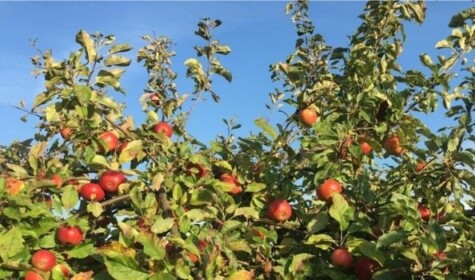I am drowning in apples. Last year, our 15 trees produced hardly any fruit. This year, the branches are breaking they are so laden with produce. A wet autumn, followed by an icy spring and a hot summer has made for the best apple growing season in years. I have given away so many apples in the last few weeks, my friends won’t accept them anymore. “Please no more apples,” they beg.
Of course, this is not a new dilemma to the residents of Somerset. They have had more apples than they knew what to do with for centuries. Hence, the reason 18th and 19th century farm labourers were paid up to a fifth of their wages in cider. So with a little help from some proper locals (not blow-ins like me) I now have five new ways to cook with apples to use my bumper harvest, which don’t all require a dollop of cream on top.
Dry them
Dried Apples, along with other dried fruit, is a snacking favourite. I find myself munching through them at night when I want something sweet but am trying to avoid chocolate! More culinary types might cook with them, and put them in winter compotes.
Don’t bother peeling the apples. Just core and slice them thinly. Stop them turning brown by dipping the slices in a solution of lemon juice and water (try adding a bit of pineapple juice or honey for extra sweetness). At this stage, you can also sprinkle the slices with cinnamon if you wish.
You can dry apples in several ways – by using the oven, a wood stove, or a dehydrator. These can be quite pricey, but Lakeland and Amazon both do a three-tiered machine for around fifty pounds. (There are also plenty kicking around on eBay). Alternatively, turn your oven on, at a low heat (100 degrees Celsius) and place your slices on baking paper on the top or bottom racks.
Cook the slices for an hour, turn them over and cook for another hour. If you want them to crisp, leave them longer. Then open the oven door slightly and leave until the oven has completely cooled. These dried apples will keep in an airtight container for a week.
Puree them
Apple puree can be used in a variety of ways – apple crumbles, apple pies or just as it is. It can also be made into fruit leather, very similar to the type you buy in little packages to put in kids lunch-boxes. This recipe was given to me by Suzanne Wynn, who is chairwoman of my local orchard group, and is tireless in her efforts to make sure apples are fully appreciated.
For this you need a good thick puree, which isn’t too sweet. (Too much sugar will make the leather tacky when dried). Spread a thin layer of the puree onto a baking tray lined with baking parchment. Put these baking sheets into a very low oven – a fan oven is ideal. Set this about 80˚C or use the bottom of an Aga. Leave overnight – it may need the next day as well – until it resembles chamois leather and peels away from the baking parchment easily. Roll the leather in the parchment and store in an airtight tin.
Pickle them
One of the best ways to get through your windfalls is to turn them into cider. However, cider making takes a degree of dedication (and equipment), which personally I don’t have the patience for. Far quicker is apple vodka! You can always fool yourself that you’ll give it away as Christmas presents.
For this you need to roughly chop about five apples and stuff them into a preserving jar. You can also add a couple of cinnamon sticks for a festive touch. Pour a 750 ml bottle of vodka into the jar, shake well and seal for between 3 – 14 days. Strain and pour back into clean bottles. Drink over ice or add to cider cocktails to really get your Christmas going.
Juice them
Homemade apple juice is far tastier than any commercial variety, and you can experiment by mixing different apples to get a sweeter or sourer flavour. Unlike orange juice, to make apple juice you must have a juicer. They vary in price, but you can get a decent one for under a hundred quid. Alternatively, you can hire a traditional wooden apple press, which will crush a whole bag of apples in one pressing.
Fresh apple juice will keep for 2 – 3 days in the fridge but you also can freeze it, either in sterilised bottles or plastic freezer bags. You can also pasteurise apple juice, which may kill some of its nutrients, but will enable you to keep it outside of the fridge for months. This is a quite a scientific operation, however, that requires a large pan of water, a stove and a long thermometer. The crucial element is to keep your bottles at the right temperature for enough time for the pasteurisation to occur. For full details read this.
Bake them
If all else fails, you can always bake, it’s a very solid way to cook with apples! I have been doing this obsessively now for two months, to the point that even my kids are fed up with my apple-laden cakes and puddings. Baking apples is such a British tradition that every celebrity chef has their own version of apple crumble, apple pie or apple cake. The following recipe is a favourite of mine and is based on the traditional Somerset apple cake.
What I particularly like is that the apples go into the mixture uncooked and then bake to a lovely consistency inside the cake. It also means the kids can get involved preparing the apples.
My top tip? Buy an all-in-one apple peeler/slicer/corer for under a tenner. Stephen Fry rates it as number nine in his list of the ‘top 100 gadgets of all time.’ Pathetic? Don’t judge until you’ve given it go!



